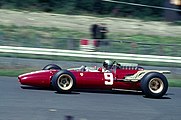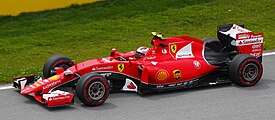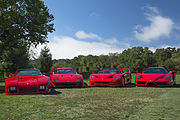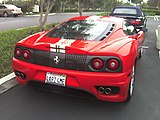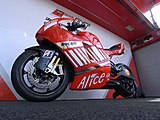
Ferrari S.p.A. is an Italian luxury sports car manufacturer based in Maranello, Italy. Founded in 1939 by Enzo Ferrari (1898–1988), the company built its first car in 1940, adopted its current name in 1945, and began to produce its current line of road cars in 1947. Ferrari became a public company in 1960, and from 1963 to 2014 it was a subsidiary of Fiat S.p.A. It was spun off from Fiat's successor entity, Fiat Chrysler Automobiles, in 2016. In 2024, the Wall Street Journal summed up the company's reputation in this way: "Ferrari has been synonymous with opulence, meticulous craftsmanship and ridiculously fast cars for nearly a century."
Scuderia Ferrari, currently competing as Scuderia Ferrari HP, is the racing division of luxury Italian auto manufacturer Ferrari and the racing team that competes in Formula One racing. The team is also known by the nickname "The Prancing Horse", in reference to their logo. It is the oldest surviving and most successful Formula One team, having competed in every world championship since 1950.
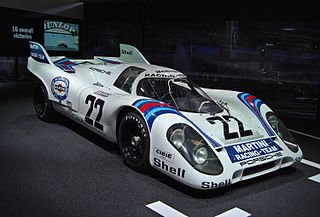
Martini Racing is the name under which various motor racing teams race when sponsored by the Italian company Martini & Rossi, a distillery that produces Martini vermouth in Turin. Martini's sponsorship program began in 1958 as Martini International Club, founded by Count Metello Rossi di Montelera of Martini & Rossi. The race cars were marked with the distinctive dark blue, light blue and red stripes mostly on white or silver background body cars, but also red or green ones.

Emilio Giuseppe "Nino" Farina, often known by the name Giuseppe Antonio Farina, was an Italian racing driver. He was the Italian National Champion in 1937, 1938, and 1939, and in 1950 became the first World Drivers' Champion during the FIA's inaugural season of Formula One.

The Italian Grand Prix is the fifth oldest national motor racing Grand Prix, having been held since 1921. Since 2013, it has been the Grand Prix held the most times, with 93 editions as of 2023. It is one of the two Grands Prix which has run as an event of the Formula One World Championship Grands Prix every season, continuously since the championship was introduced in 1950. Every Formula One Italian Grand Prix in the World Championship era has been held at Monza except in 1980, when it was held at Imola.

The 1950 British Grand Prix, formally known as The Royal Automobile Club Grand Prix d'Europe Incorporating The British Grand Prix, was a Formula One motor race held on 13 May 1950 at the Silverstone Circuit in Silverstone, England. It was the first World Championship Formula One race, as well as the fifth British Grand Prix, and the third to be held at Silverstone after motor racing resumed after World War II. It was the first race of seven in the 1950 World Championship of Drivers.

The 1961 Belgian Grand Prix was a Formula One motor race held on 18 June 1961 at Spa-Francorchamps. It was race 3 of 8 in both the 1961 World Championship of Drivers and the 1961 International Cup for Formula One Manufacturers.

The 1964 Mexican Grand Prix was a Formula One motor race held at the Ciudad Deportiva Magdalena Mixhuca in Mexico City on October 25, 1964. It was race 10 of 10 in both the 1964 World Championship of Drivers and the 1964 International Cup for Formula One Manufacturers.
The 1950 Formula One season was the fourth season of the FIA's Formula One motor racing. It featured the inaugural FIA World Championship of Drivers, as well as several non-championship races. The championship, which commenced on 13 May and ended on 3 September, consisted of six Grand Prix races, each held in Europe and open to Formula One cars, plus the Indianapolis 500, which was run to AAA National Championship regulations. Giuseppe Farina won the championship from Juan Manuel Fangio and Luigi Fagioli.

Reginald Parnell was a racing driver and team manager from Derby, England. He participated in seven Formula One World Championship Grands Prix, achieving one podium, and scoring a total of nine championship points.
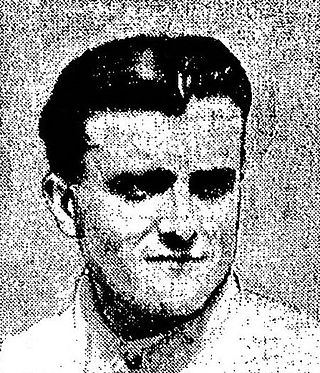
Luigi Chinetti was an Italian-born racecar driver, who emigrated to the United States during World War II. He drove in 12 consecutive 24 Hours of Le Mans races, taking three outright wins there and taking two more at the Spa 24 Hours race. Chinetti owned the North American Racing Team, which successfully ran privateer Ferraris in sports car and Formula One races. For many years he was the exclusive American importer of Ferrari automobiles to the United States.
British racing green, or BRG, is a colour similar to Brunswick green, hunter green, forest green or moss green. It takes its name from the green international motor racing colour of the United Kingdom. This originated with the 1903 Gordon Bennett Cup, held in Ireland, as motor-racing on public roads was illegal in Great Britain. As a mark of respect, the British cars were painted shamrock green.

The North American Racing Team (NART) is a motorsport racing team founded in 1958. It was created by businessman Luigi Chinetti to promote the Ferrari marque in North America through success in endurance racing.

The 1961 24 Hours of Le Mans was a motor race for Sports cars and Grand Touring cars staged at the Circuit de la Sarthe, Le Mans, France on 10 and 11 June 1961. It was the 29th Grand Prix of Endurance and the fourth race of the 1961 World Sportscar Championship. Ferrari and Maserati were the main contenders, with Aston Martin an outside chance.
Formula One sponsorship liveries have been used since the 1968 season. Before the arrival of sponsorship liveries in 1968 the nationality of the team determined the colour of a car entered by the team, e.g. cars entered by Italian teams were rosso corsa red, cars entered by French teams were bleu de France blue, and cars entered by British teams were British racing green. Major sponsors such as BP, Shell, and Firestone had pulled out of the sport ahead of this season, prompting the Fédération Internationale de l'Automobile to allow unrestricted sponsorship.
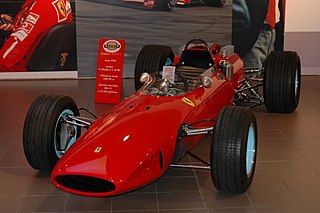
The Ferrari 158 was a Formula One racing car made by Ferrari in 1964 as a successor to the V6-powered Ferrari 156 F1.
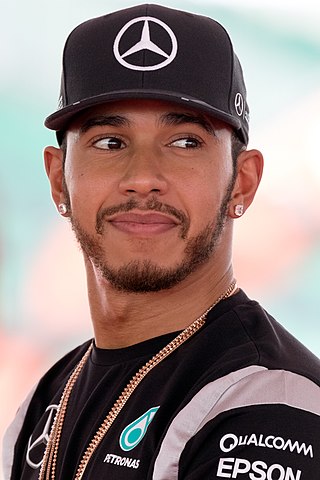
The 2019 FIA Formula One World Championship was the motor racing championship for Formula One cars which marked the 70th running of the Formula One World Championship. It is recognised by the governing body of international motorsport, the Fédération Internationale de l'Automobile (FIA), as the highest class of competition for open-wheel racing cars. Starting in March and ending in December, the championship was contested over twenty-one Grands Prix. Drivers competed for the title of World Drivers' Champion, and teams for the title of World Constructors' Champion. The 2019 championship also saw the running of the 1000th World Championship race, the 2019 Chinese Grand Prix.
This article gives a general overview of motorsport in Italy. For a more exhaustive view see; Motorsport in Italy by decade and Motorsport in Italy by year. Motorsport is widely popular in Italy, and its history spans over a century back to the early 1900s. Today, Italy is considered a hub of motorsport in terms of racing venues, drivers, teams, and manufacturers. It hosts annual races across Formula One, MotoGP, the World Touring Car Cup, and other prominent motor racing series.



